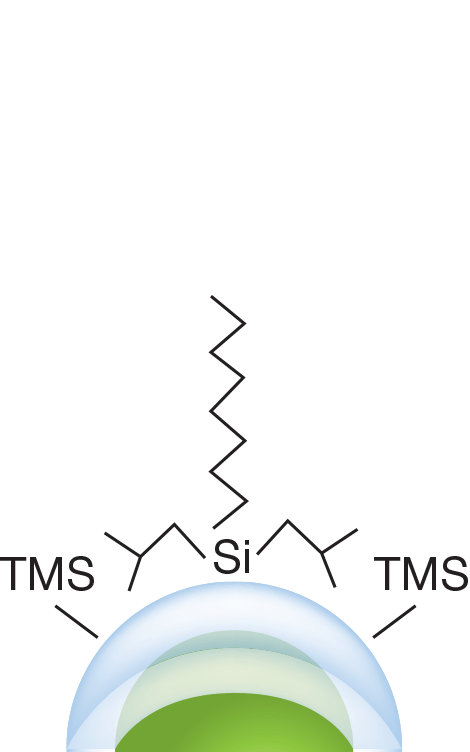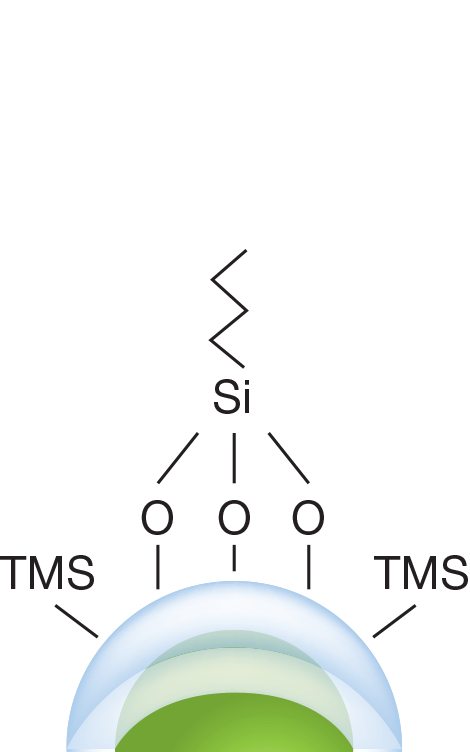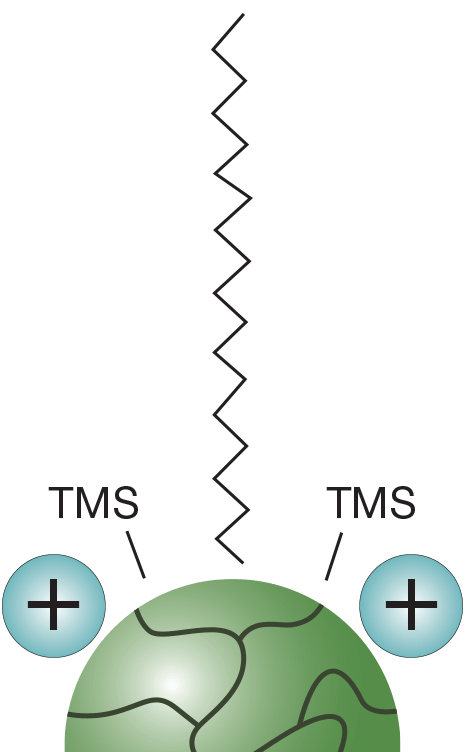The Biozen dSEC columns are packed with low pore volume silica coupled with a proprietary hydrophilic diol-type bonded surface chemistry that prevents the silica surface from interacting with protein samples.

Biozen Biologics LC Columns
Explore Biozen LC Portfolio
With a new titanium BioTi™ biocompatible hardware to minimize priming, four particle platforms for optimal versatility and nine particle chemistries to maximize selectivity and sensitivity, Biozen UHPLC/HPLC columns for protein analysis are seamlessly designed to bring peace of mind to your analysis of biologics through:

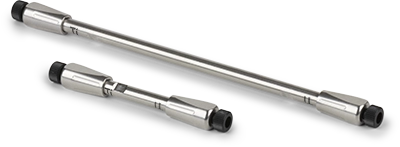
Biocompatible Flow Path with BioTi™ Hardware
Keep your mind at ease knowing that we’ve minimized the need for priming with a new titanium infused biocompatible hardware and frit that doesn’t interfere with protein or peptide integrity!

A: UHPLC Pressure Rating Allows for more experimental design space; room to increase flow rates for increased throughput |
B: Better Controlled ID Versus PEEK Hardware Improved column-to-column performance, providing more consistency and easier method validation |
C: Biocompatible Titanium Liner |
D: Improved Recovery and Peak Shape Better column-to-column consistency, ease of use, and troubleshooting |
E: Strong Stainless Steel Walls Help Prevent Movement Under Pressure |
F: Biocompatible Titanium Frit |
4 Advanced Particle Platforms
All four of the Biozen particle platforms were individually designed and built by Phenomenex to take advantage of integral levels of performance, ruggedness, and reproducibility for protein characterization applications. Individually, each platform differs in the proprietary processing techniques used to control particle size and morphology.
Pore Controlled Technology

Monosized Polymeric
Non-Porous

Core-Shell Technology

Thermally Modified
Fully Porous

Meticulously controlled monosized particle technology secures incredible particle consistency that leads to improved and reliable efficiency. This innovative non-porous particle serves as the perfect backbone for complex ion-exchange chemistries.
Using sol-gel processing techniques that incorporate nano structuring technology, a durable, homogeneous porous shell is grown on a solid silica core. This highly optimized process combined with industry leading column packing technology produces highly reproducible columns that generate extremely high efficiencies and sensitivity.
Through a proprietary thermal processing series of steps, we eliminate micropores and further improve consistency, column efficiency, inertness, ruggedness, and reproducibility.
11 Particle Chemistries
Oligonucleotide Analysis
The Biozen Oligo LC column brings a unique combination of improved chromatographic efficiency from its core-shell morphology and high pH stability necessary for oligonucleotide characterization. Biozen Oligo is packed in a unique bio-inert titanium hardware developed to mitigate non-specific interactions that lead to analyte loss, distortions in peak shape and carry over. Confidently maximize resolution and reproducibility throughout the most demanding of method extremes with Biozen Oligo.
LC-MS Analysis of siRNA using BioTi UHPLC Hardware
Bio-inert hardware gives clear separation of the sense and anti-sense strand. View application>>
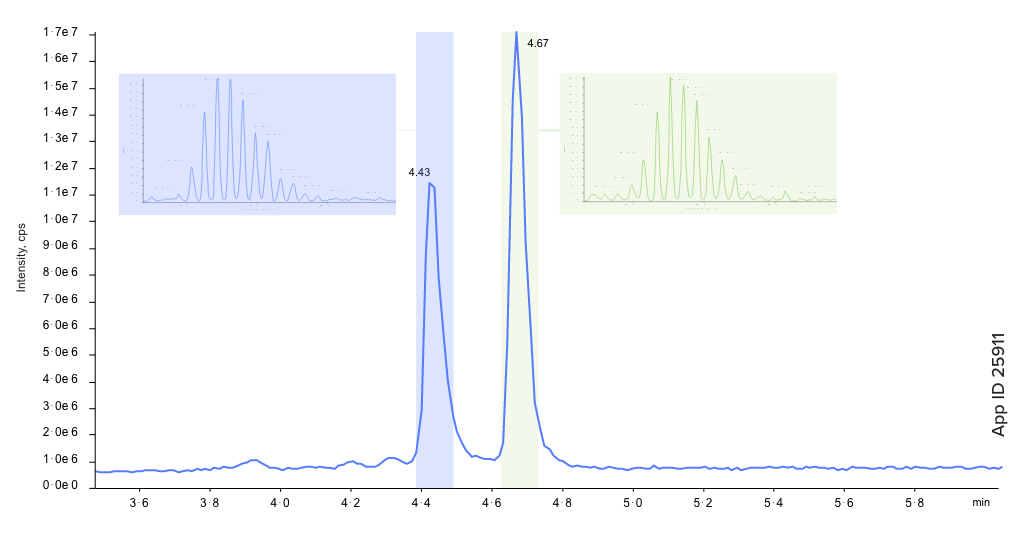
|
Columns:
Biozen 2.6 μm Oligo ( BioTi™)
Clarity 2.6 μm Oligo XT (stainless steel) |
|
Dimensions
100 x 2.1 mm
|
|
Part No.:
|
|
Mobile Phase:
A: A: 4 mM Triethylamine in Water + 12.5 mM
Hexafluoro 2 propanol
B: B: 4 mM Triethylamine in Methanol + 12.5 mM Hexafluoro 2 propanol |
vs
LC-MS Analysis of siRNA using Stainless Steel UHPLC Hardware
Non-specific interactions were observed using stainless steel hardware resulting in bimodal peak for late eluting anti-sense strand.
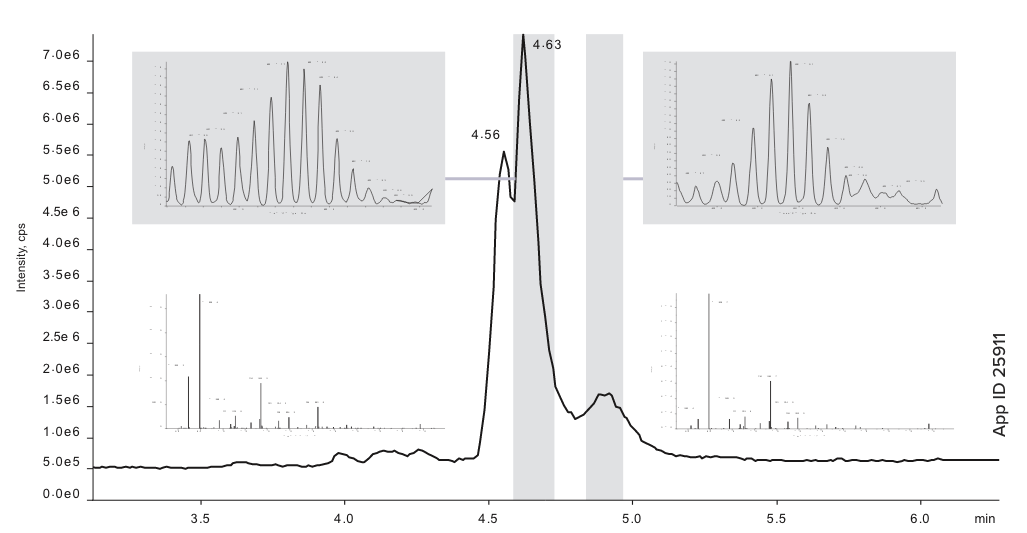
|
Gradient:
Time (min)
0
2
16
16.1
20
20.1
|
% B
5
5
30
95
95
5
|
|
Flow Rate:
0.3 mL/min
|
|
|
Temperature:
55 °C
|
|
|
Instrument:
Shimadzu® LC 20A Prominence®
|
|
|
Detection:
TOF-MS
|
|
|
Detector:
SCIEX® TripleTOF ® 6600
|
|
Peptide Mapping
Digested mAbs or ADCs typically include a large body of compounds which are crucial to understanding post translation modifications. So we designed two Biozen Peptide columns to offer uniquely different selectivity profiles for these types of bioseparations. Each allows for fast and effective elution windows by utilizing either high efficiency core-shell or thermally modified fully porous particles to gain sharper peaks, better peak capacities, and overall higher sensitivity.
Trastuzumab Biosimilar Peptide Map

Infliximab Biosimilar Peptide Map

Conditions for all columns:
|
Column:
|
|
|
Dimensions
150 x 2.1 mm
|
|
|
Part No.:
|
|
|
Mobile Phase:
A: 0.1 % Formic Acid in Water
B: 0.1 % Formic Acid in Acetonitrile |
Gradient:
Time (min)
0
0.5
50
55
56
| % B
1
1
50
50
95 |
Flow Rate:
0.3 mL/min |
|
Temperature:
40 °C |
|
Detection:
QTOF (SCIEX® X500B) |
|

|
Column:
Biozen 3 µm dSEC-7
|
|
Dimensions
150 x 4.6 mm
|
|
Part No.:
|
|
Mobile Phase:
200 Potassium Phosphate +
250 mM KCl, pH 6.2 |
|
Part No.:
00H-4787-E0
|
|
Mobile Phase:
20 mM Sodium Phosphate, pH 6.6 + 350 mM Potassium Chloride
|
|
Flow Rate:
350 µL/min (Isocratic)
|
|
Injection Volume:
|
|
Temperature:
25 °C
|
|
Instrument:
Waters® ACQUITY® H-Class
|
|
Detection:
FLR - Ex 280 nm, Em 350 nm
Sampling Rate: 40 Hz |
|
Sample:
1. AAV2-CAG-GFP, 2E13 vg/mL
2. AAV5-CMV-GFP, 2E13 vg/mL 3. AAV8-CMV-GFP, 2E13 vg/mL 4. AAV9-CMV-GFP, 2E13 vg/mL |

|
Column:
Biozen 1.8 µm dSEC-2, 200 Å
|
|
Dimensions
300 x 4.6 mm
|
|
Part No.:
|
|
Mobile Phase:
200 Potassium Phosphate +
250 mM KCl, pH 6.2 |
|
Part No.:
00H-4787-E0
|
|
Flow Rate:
0.35 mL/min
|
|
Injection Volume:
10 µL
|
|
Temperature:
25 °C
|
|
Detection:
UV @ 280 nm
|
|
Sample:
Various,10 mg/mL
|
Trastuzumab (MES Salt Gradient)
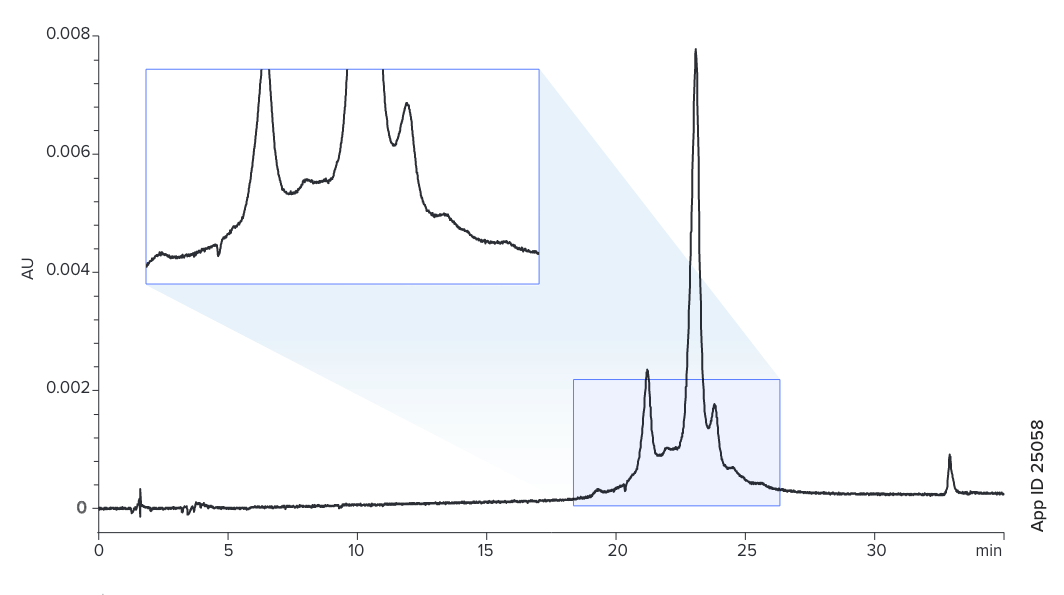
|
Column:
Biozen 6 μm WCX
|
|
|
Dimensions
250 x 4.6 mm
|
|
|
Part No.:
|
|
|
Mobile Phase:
A: 20 mM MES (pH 5.6)
B: 20 mM MES + 300 mM NaCl (pH 5.6) |
|
|
Gradient:
Time (min)
0
1
31
31.1
34
35
|
% B
15
15
45
100
100
15
|
|
Flow Rate:
1 mL/min
|
|
|
Temperature:
30 °C
|
|
|
Detection:
UV @ 280 nm
|
|
|
Sample:
Trastuzumab
|
|
Trastuzumab (pH Gradient Buffer)
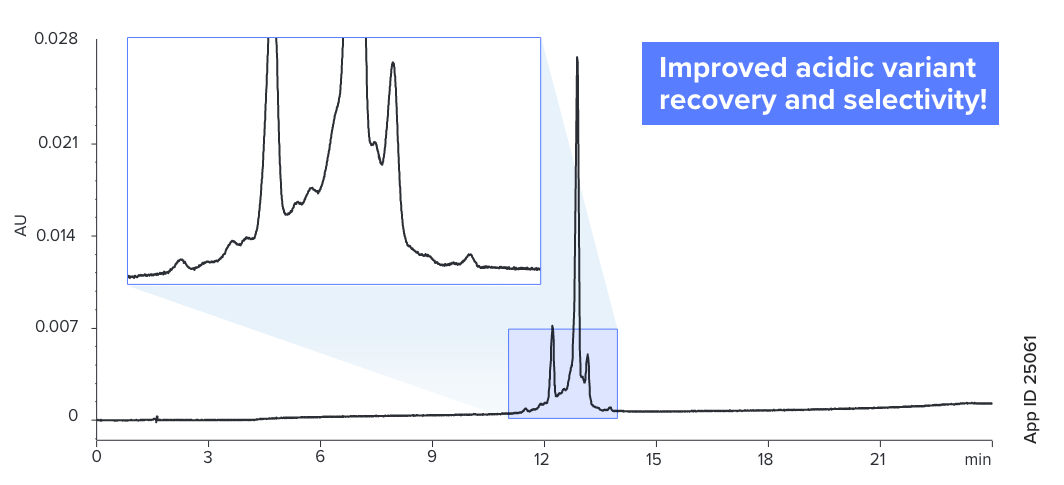
|
Column:
Biozen 6 μm WCX
|
|
|
Dimensions
250 x 4.6 mm
|
|
|
Part No.:
|
|
|
Mobile Phase:
A: CX -1 (pH 5.6) pH Gradient Buffer*
B: CX -1 (pH 10.2) pH Gradient Buffer*
|
|
|
Gradient:
Time (min)
0
1
21
23
24
|
% B
0
0
100
100
0
|
|
Flow Rate:
1 mL/min
|
|
|
Temperature:
30 °C
|
|
|
Detection:
UV @ 280 nm
|
|
|
Sample:
Trastuzumab
|
|
* From Thermo Fisher Scientific® Inc.
Intact and Subunit Analysis
Impurity profiling and characterization of intact biologics and fragments is a challenging undertaking because of the need to identify very small differences between variants. Both Biozen Intact columns. contain skillfully manufactured large pore core-shell particles that provide narrower, taller peaks in conjunction with higher resolution between the target mAb HC/LC, Fc/Fab, or isoforms.
Intact Trastuzumab at 70, 80, and 90 °C

|
Column:
Biozen 3.6 µm Intact XB-C8
|
|
|
Dimensions
150 x 2.1 mm
|
|
|
Part No.:
|
|
|
Mobile Phase:
A: 0.1 % TFA in Water
B: 0.1 % TFA in Acetonitrile
|
|
|
Gradient:
Time (min)
0
1
13
|
% B
20
20
25
|
|
Flow Rate:
0.5 mL/min
|
|
|
Temperature:
|
|
|
Detection:
UV @ 280 nm
|
|
|
Sample:
1. Trastuzumab
|
|
Infliximab F(ab)2
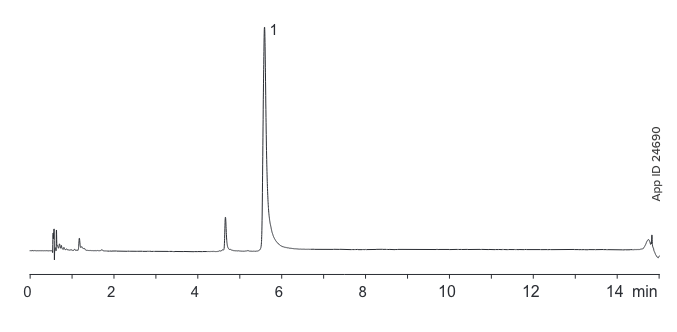
|
Column:
Biozen 3.6 µm Intact XB-C8
|
|||
|
Dimensions
150 x 2.1 mm
|
|||
|
Part No.:
|
|||
|
Mobile Phase:
A: 0.1 % TFA in Water
B: 0.1 % TFA in Acetonitrile
|
|||
|
Gradient:
Time (min)
0
1
13
|
% B
20
20
60
|
||
|
Flow Rate:
0.5 mL/min
|
|||
|
Temperature:
80 °
|
|||
|
Detection:
UV @ 280 nm
|
|||
|
Sample:
|
|||
Cetuximab
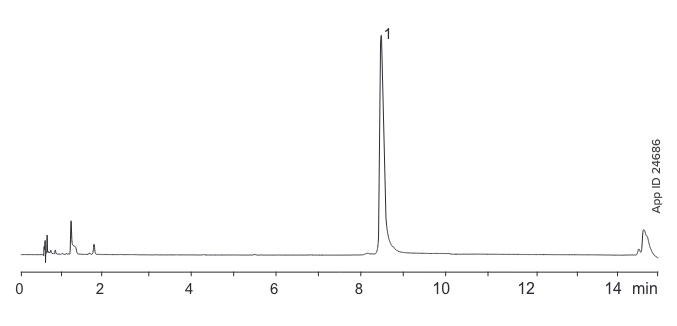
|
Column:
Biozen 3.6 µm Intact XB-C8
|
|||
|
Dimensions
150 x 2.1 mm
|
|||
|
Part No.:
|
|||
|
Mobile Phase:
A: 0.1 % TFA in Water
B: 0.1 % TFA in Acetonitrile
|
|||
|
Gradient:
Time (min)
0
1
13
|
% B
20
20
45
|
||
|
Flow Rate:
0.5 mL/min
|
|||
|
Temperature:
80 °
|
|||
|
Detection:
UV @ 280 nm
|
|||
|
Sample:
|
|||
Intact Mass Analysis
Intact Mass of Trastuzumab Biosimilar using a Biozen Intact XB-C8 and SCIEX® X500B

|
Column:
Biozen 3.6 µm Intact XB-C8
|
|
|
Dimensions
150 x 2.1 mm
|
|
|
Part No.:
|
|
|
Mobile Phase:
A: 0.1 % Formic Acid in Water
B: 0.1 % Formic Acid in Acetonitrile /
Isopropyl alcohol (50:50
|
|
|
Gradient:
Time (min)
2.5
10
110.1
|
% B2
0
65
95
|
|
Flow Rate:
0.3 mL/min
|
|
|
Temperature:
90 °
|
|
|
Detection:
QTOF (SCIEX X500B)
|
|
|
Sample:
Trastuzumab
|
|
Drug Antibody Ratio (DAR)
Herceptin—vcMMAE using Biozen 3.6 µm Intact XB-C8

Herceptin—mcMMAF using Biozen 3.6 µm Intact XB-C8

Peptide Quantitation

|
Column:
Biozen 3 µm Peptide PS-C18
|
|
|
Dimensions
50 x 2.1 mm
|
|
|
Part No.:
|
|
|
Mobile Phase:
A: 0.1 % Formic Acid in Water
B: 0.1 % Formic Acid in Acetonitrile |
|
|
Gradient:
Time (min)
0
1
4.5
|
%B
3
3
25
|
| Flow Rate:
0.5 mL/min
|
|
| Temperature:
22 °C |
|
| LC System:
ExionLC™ AD HPLC |
|
|
Detection:
MS/MS
|
|
|
Detector:
SCIEX QTRAP® 5500
|
|
|
Flow Rate:
1.85 mL/min
|
|
|
Sample:
As noted
|
Glycan Analysis
Intact Mass of Trastuzumab Biosimilar using a Biozen Intact XB-C8 and SCIEX® X500B
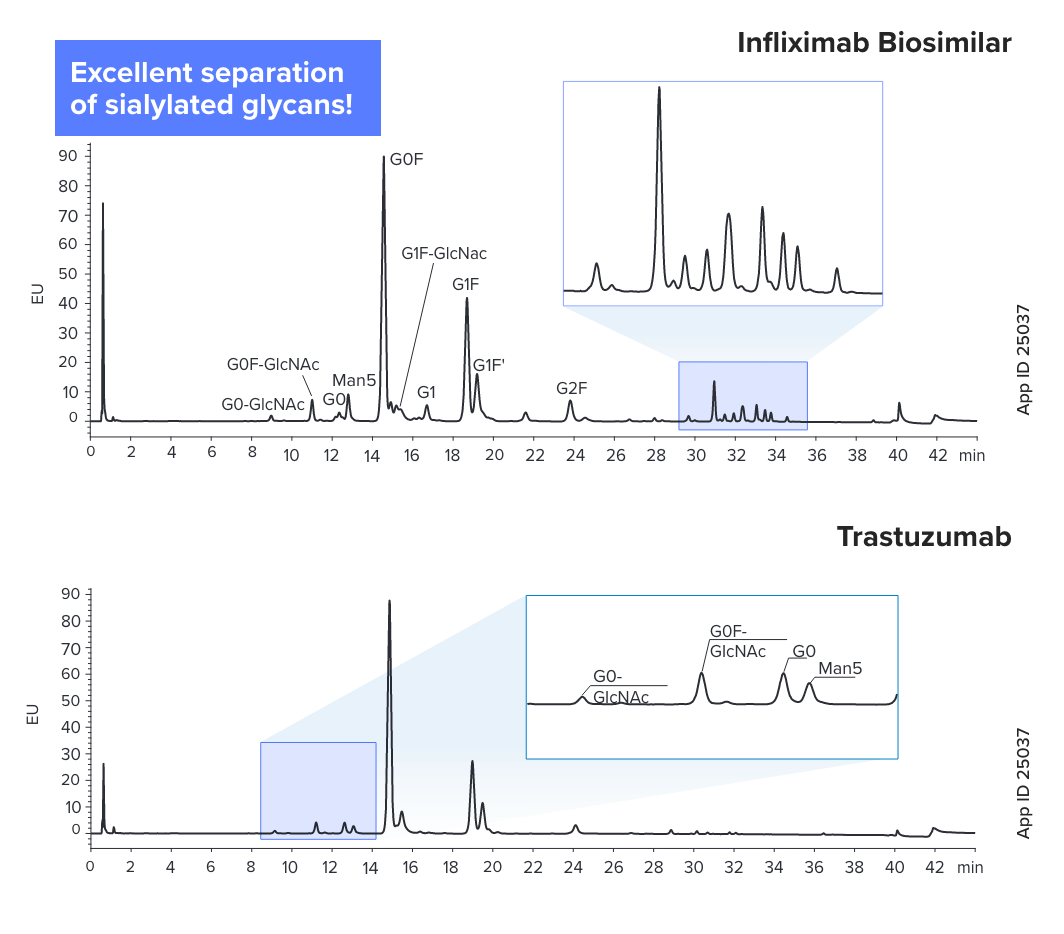
|
Column:
Biozen 2.6 µm Glycan
|
|
|
Dimensions
150 x 2.1 mm
|
|
|
Part No.:
|
|
|
Mobile Phase:
A: 100 mM Ammonium Formate, pH 4.5
B: Acetonitrile |
|
|
Gradient:
Time (min)
0
10
24
38.5
38.6
40.6 40.7 48 |
% B
78
74.5 72 55.9 40 40 78 78 |
|
Flow Rate:
0.5 mL/min
|
|
|
Temperature:
50 °C
|
|
|
Detection:
FLD ex/em 285/345 nm
|
|
|
Sample:
As noted
|
|






